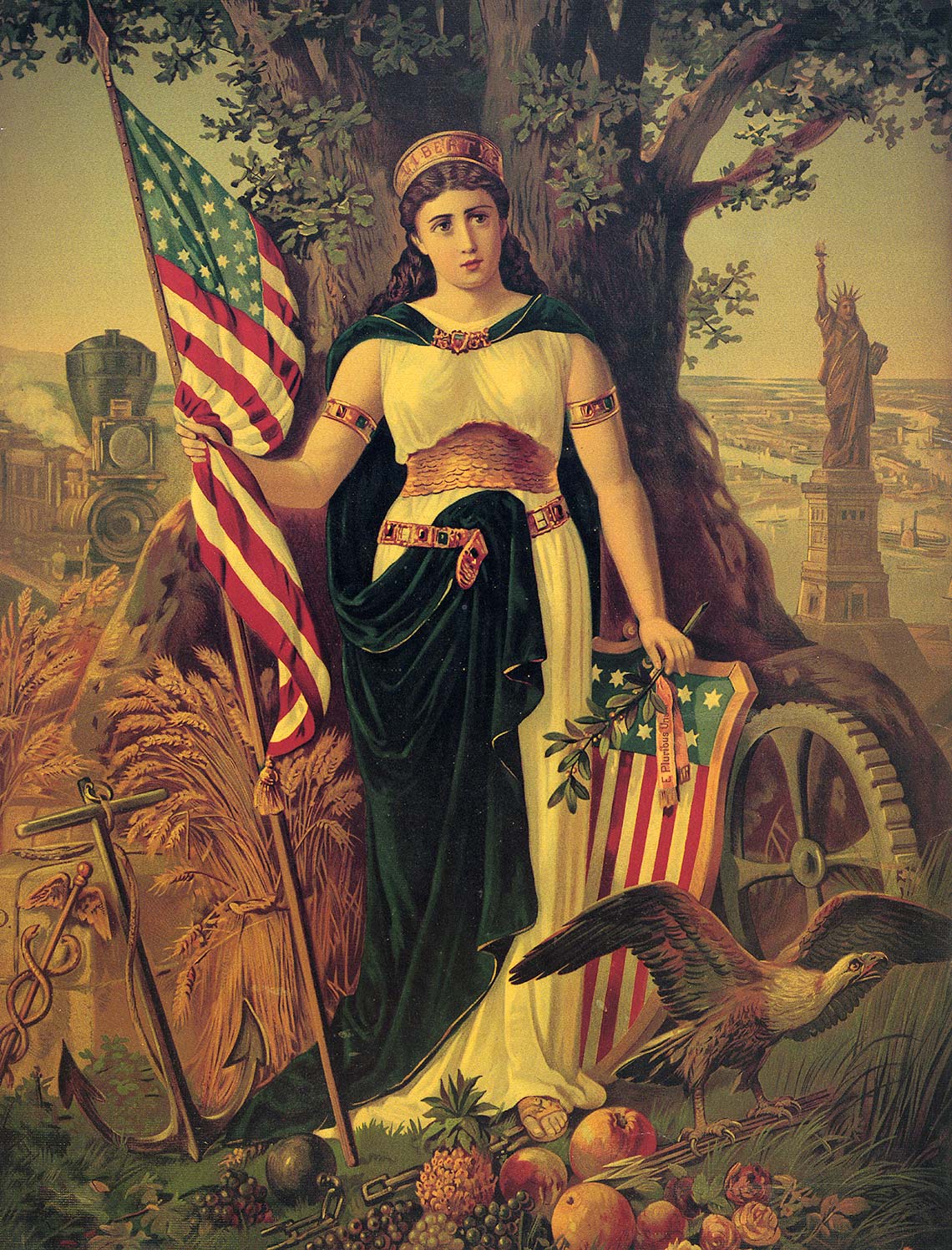


Our National Heritage
FRAMERS OF WASHINGTON’S CONSITUTION WERE HEIRS TO AN AMERICAN TRADITION OF CONSTITUTION MAKING
"The streams of power we trace…to one great and noble source, The People."
James Wilson, Pennsylvania Ratifying Convention
November 24, 1787
Balancing power with power
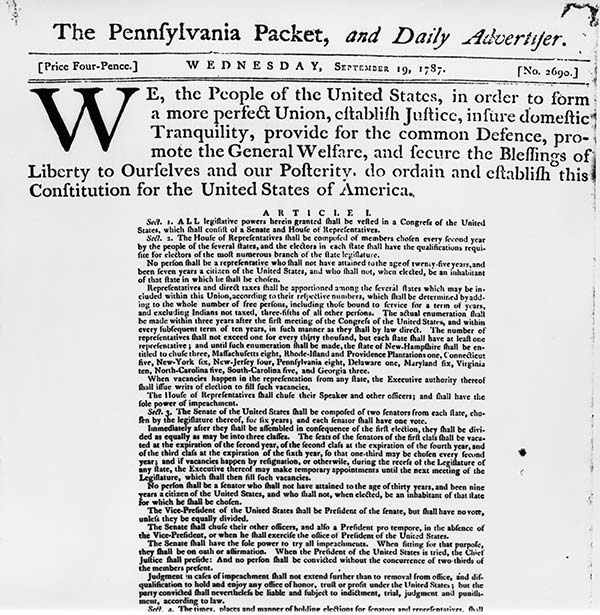
To the American way of thinking, a written Constitution is essential for just and effective government. In a constitution, the people delegate, distribute and guard against the misuse of power.
At the Constitutional Convention at Philadelphia in 1787, the Founding Fathers worked to create a government strong enough to serve its citizens, but under sufficient restraint to keep it from becoming their master. Power was balanced with power in three branches of government: the Executive, the Legislative and the Judicial.
Documents of Libery and Justice

Constitutions are not only working plans for government, but also documents of ideas about the meaning of freedom, the nature of justice, and the sources and limits of authority.
The Constitutional Tradition
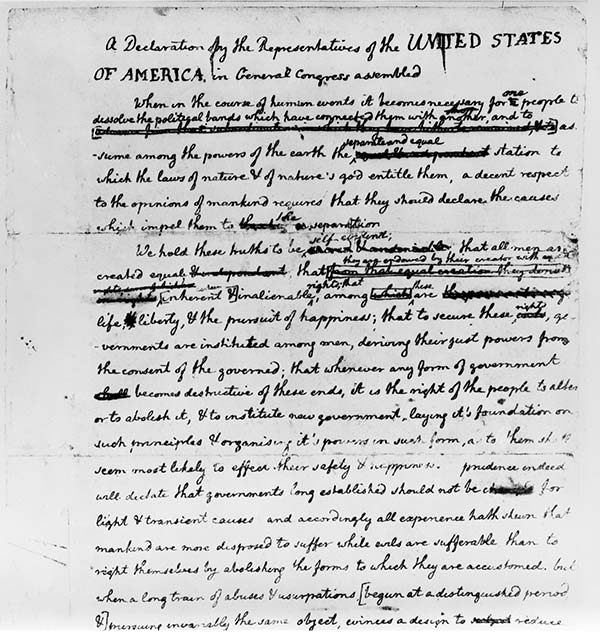
To English-speaking peoples before the American Revolution, the word "constitution" meant the body of laws, customs and understandings which governments were expected to follow. For more than 150 years the relationship of the American colonies to the British government was set forth in a series of written documents such as acts of Parliament, royal decrees and charters.
When constitutional conflicts over the stamp tax and other issues ended in revolution, the former colonists not only declared their independence, but took steps to put their own understandings of fundamental law into document of the most authoritative kind—written constitutions.
Will of the People
To assure that a constitution will actually restrain lawmakers and government officials from going beyond the limits set for them by the people, a constitution is elevated above ordinary law.
The tradition of constitutional conventions began in Massachusetts in 1780 when a specially elected convention rather than the Legislature drafted a constitution to be submitted to a vote clearly reflecting the people's will.
“We hold these truths to be self-evident, that all men are created equal, that they are endowed by their Creator with certain unalienable Rights…That to secure these Rights, Governments are instituted among Men, deriving their just powers from the consent of the governed.”
Declaration of Independence, 1776
“If men were angels, no government would be necessary….In framing a government which is to be administered by men over men….You must first enable the government to control the governed; and in the next place, oblige it to control itself.”
James Madison
“Father of the Constitution”
The Federalist, No. 51
Equal Justice Under Law
The original U.S. Constitution of 1787 provided guarantees of jury trial, of habeas corpus (a court petition seeking release of a person wrongfully jailed) and important safeguards in treason trials, but lacked a separate Declaration of Rights customary in state constitutions. In 1789-991, the first ten amendments which came to be known as the Bill of Rights were added to the Constitution.
In 1865-70, following the Civil War, amendments abolished slavery, gave national citizenship to native-born and naturalized Americans, and expanded the Bill of Rights to cover actions by individual states. Suffrage for women was among the amendments added in the twentieth century.
Supreme Law of the Land

“The Constitution of the United States is the Supreme law of the land.” Article 1 Section 2 Washington State Constitution, 1889
A durable foundation for the nation’s political life, the United States Constitution stands as the supreme law of the land—a phrase of the constitution given practical effect in a multitude of decisions by the Supreme Court.
A landmark document, the Washington State Constitution of 1889 continued the American tradition of constitution-making in the west. When it was adopted one hundred years after George Washington was inaugurated as the nation’s first president, the state bearing his name was admitted to the Union.
A More Perfect Union
The Northwest Ordinance of 1787 providing for the entry of new states into the Union completed the basic Constitutional foundations of the United States of America.
The constitutional processes inaugurated at the very beginning of our national life have continued without interruption ever since.



Early Washington History
WASHINGTON TERRITORY CREATED
SEEKING STATEHOOD · THE RAILROADS
The Promise of Statehood

Anticipating westward expansion Congress passed the Northwest Ordinance of 1787 providing American settlers in territory northwest of the Ohio River a limited measure of self-government. The law guaranteed rights and promised that new states could enter the Union on an equal footing with the thirteen original states.
The land that was to become the state of Washington came under U.S. jurisdiction when the so-called Oregon country was divided between the United States and Canada at the 49th parallel by treaty with Great Britain in 1846.
Washington Territory Created




Fourth of July orations in Olympia in 1852 led to conventions at Cowlitz Landing and Monticello (now Longview) and the formal request for a separate Territory north of the Columbia River. Congress granted this in 1853 naming the new territory “Washington” rather than “Columbia” as residents had proposed.
American Indian Citizenship
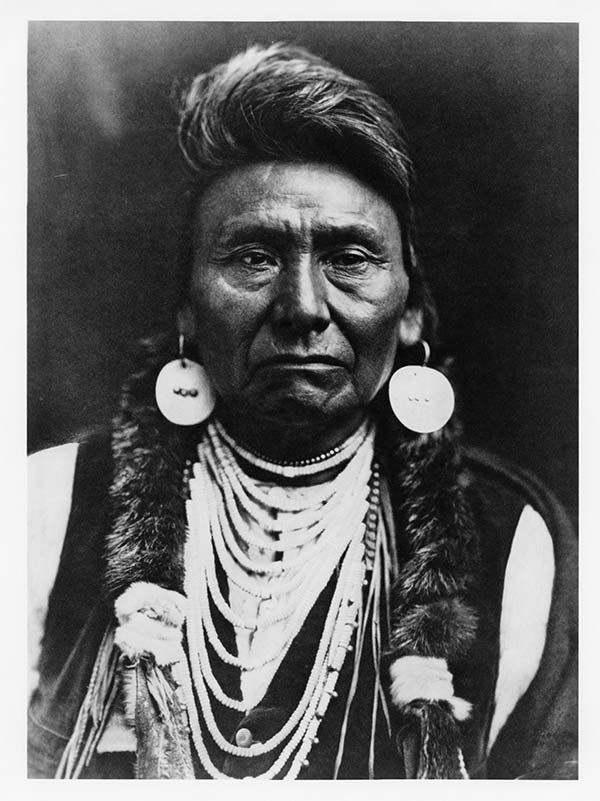
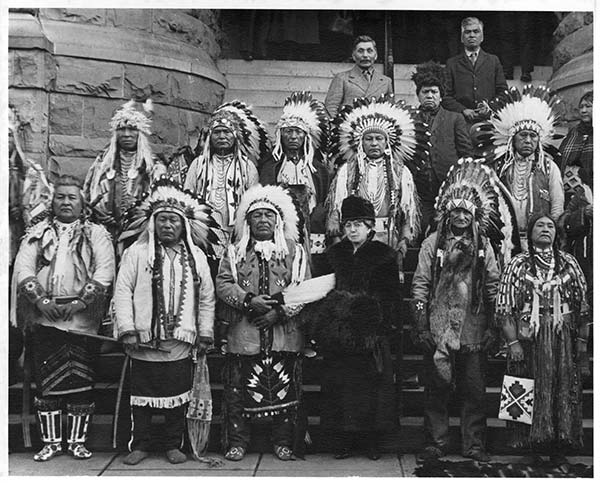
The first Territorial Governor, Isaac I. Stevens, conducted treaty signing councils to create reservations of land for native peoples. Tribal governments with treaty rights under federal jurisdiction evolved. Congress granted full U.S. citizenship to American Indians in 1924.
First State Constitutional Convention

From the 1870’s on, the Washington Territorial Legislature repeatedly petitioned Congress for statehood. In 1878 the first state constitution was written at Walla Walla, then the territory’s most populous town. Voters approved it, but Congress, not having authorized it, did not.
Votes for Women

A major issue at both state constitutional conventions, women’s suffrage was twice referred to and defeated by the voters. In 1910 voters amended the constitution and Washington became the fifth state to grant women the right to vote.
The Railroads
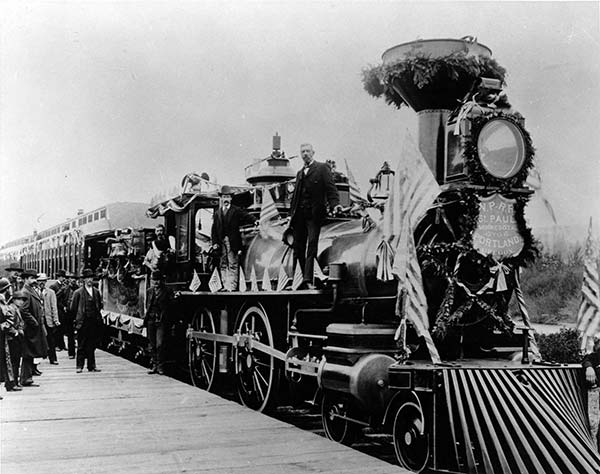

The coming of the nation’s second transcontinental railroad to Tacoma in 1883 brought an end to frontier days in Washington Territory. Attempts to drive out the Chinese after completion of work on the railroad, however, caused Washington Territory to be condemned in the eastern press as “too unruly for statehood.”
Railroad literature promoted the rich farming potential of the West in eastern states and Europe. An economic boom in the late 1880s and the promise of fertile land attracted the additional population needed for statehood.



The Quest for Statehood
ON GEORGE WASHINGTON’S BIRTHDAY IN 1889 THE PRESIDENT SIGNED THE LAW ENABLING WASHINGTON TO BECOME A STATE
Statehood Promised
The Northwest Ordinance of 1787 first promised U.S. Territorial settlers that new states would be admitted to the Union "on an equal footing with the original states in all respects whatever... ."
Statehood Delayed

For many years, Congress, evenly divided between Republicans and Democrats, refused to admit new states whose Congressional delegations might change the political balance.
By the late 1880’s, the impasse was broken. On George Washington’s birthday, February 22, 1889, President Grover Cleveland signed the law authorizing the creation of four new states: Washington, Montana, and North and South Dakota. Cleveland served a four year term before and again after President Harrison who won the 1888 election. The state Constitutional Convention began on July 4,1889.
Early Pioneeers
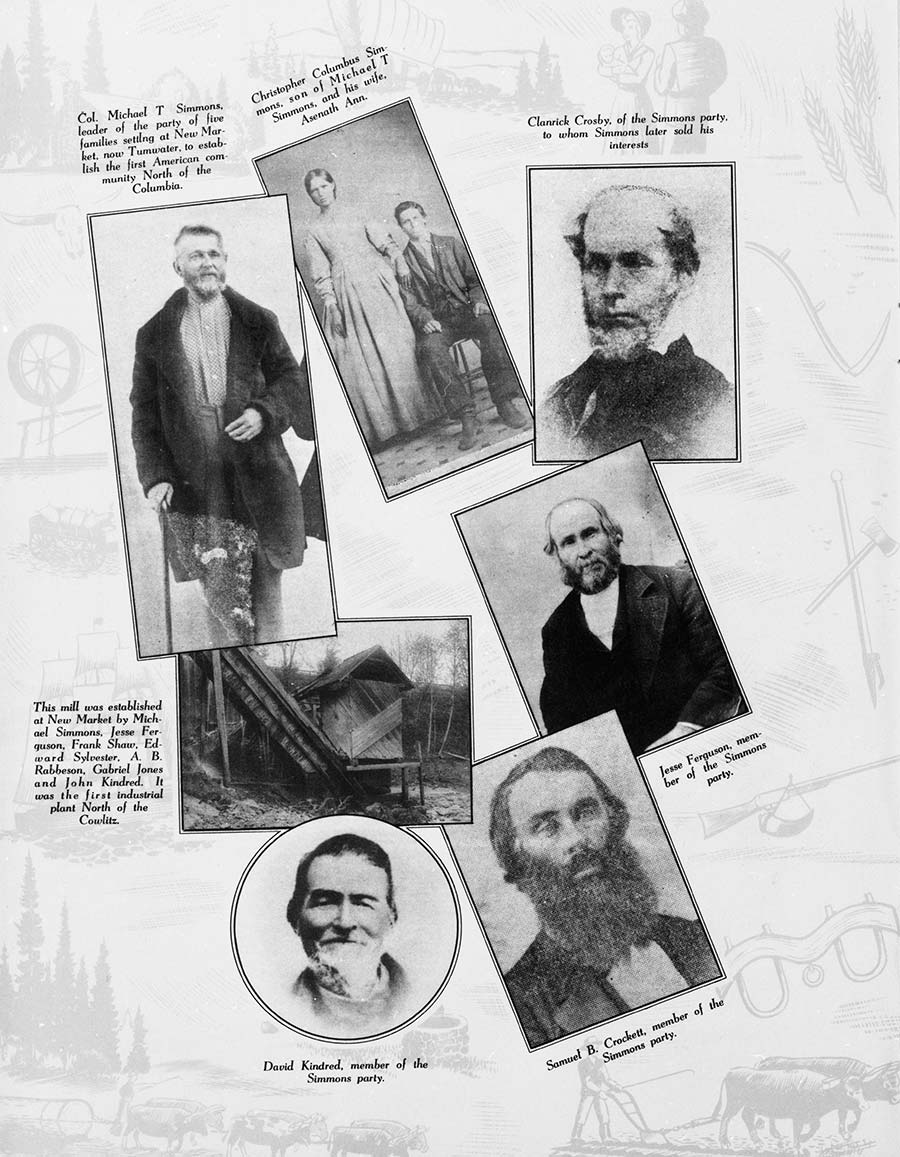
Americans first settled on the southern tip of the Puget Sound in 1845.
No photographs survive of George Washington Bush, a free black in the Simmons party which settled on the southern tip of Puget Sound in 1845.


Rights And Liberties
RIGHTS WON OVER CENTURIES OF STRUGGLE ARE PRESERVED IN THE WASHINGTON STATE CONSTITUTION
Due Process of Law
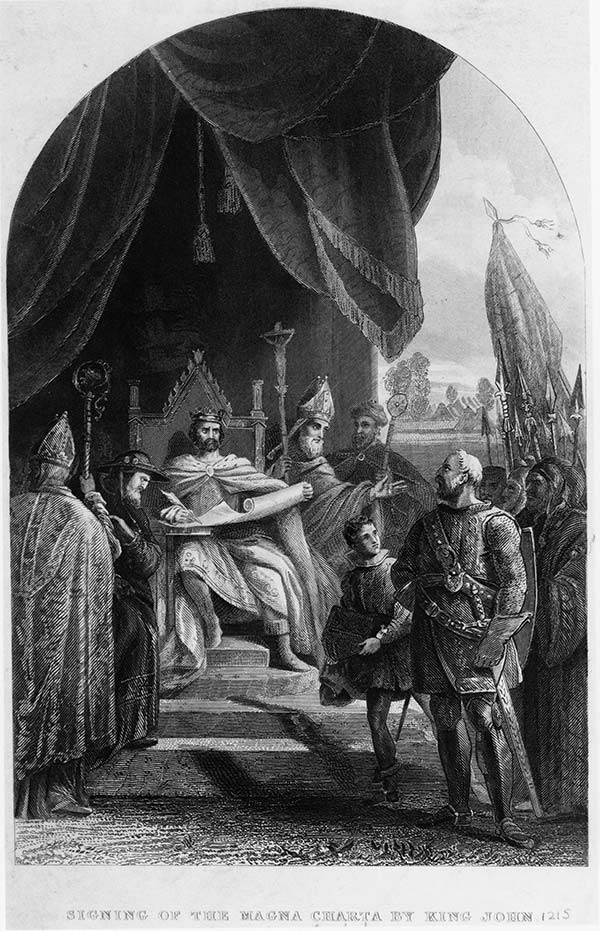
“No free man shall be taken, imprisoned, disseised,* outlawed, banished, or in any way destroyed, nor will proceed against or prosecute him, except by the lawful judgment of his Peers and by the law of the land.”
Magna Carta, 1215
*deprived of property
“No person shall be deprived of life, liberty, or property without Due Process of Law.”
Article 1, Section 1
Washington State Constitution
The Right to Petition

“That it is the Right of the subjects to Petition the King….”
English Bill of Rights, 1689
“The Right of Petition and of the people to peaceably Assemble for the common good shall never be abridged.”
Article 1, Section 4
Washington State Constitution
Trial by Jury
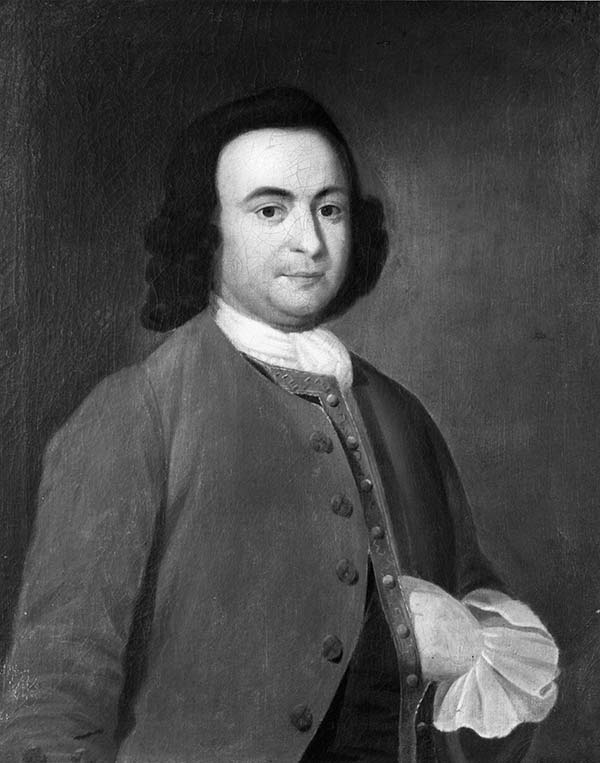
“That in all…prosecutions a man hath a Right to demand the cause and Nature of his Accusation, to be Confronted with the Accusers and Witnesses, to call for Evidence in his favour, and to a Speedy Trial by an Impartial Jury nor can he be compelled to give Evidence Against Himself….”
Virginia Declaration of Rights
“The right of Trial by Jury shall remain inviolate…”
Article 1, Section 21
Washington State Constitution
“In criminal prosecutions the accused shall have the Right to…Appear and Defend in person, and by counsel, to demand the Nature and Cause of the Accusation against him…to meet the Witnesses against him face to face…to compel the attendance of Witnesses on his own Behalf, to have a Speedy Public Trial by an Impartial Jury….” (original wording)
Article 1, Section 22
Washington State Constitution
Freedom of Speech, Press and Religion
“Congress shall make No Law respecting an establishment of Religion, or prohibiting the Free Exercise thereof, or abridging the Freedom of Speech, or of the Press, or the right of the people to peaceably Assemble, and To Petition the Government for a redress of grievances.” First Amendment
United States Constitution
“Every person may Freely Speak, Write and Publish on all subjects, being responsible for the abuse of that right.”
Article 1, Section 5
Washington State Constitution
“Absolute Freedom of Conscience in all matters of religious sentiment, belief and worship, shall be guaranteed….No religious qualification shall be required for any public office.”
Article 1, Section 11
Washington State Constitution
“A Frequent Recurrence to Fundamental Principles is Essential to the security of Individual Right and the perpetuity of Free Government.”
Article 1 Section 32
Washington State Constitution, 1889
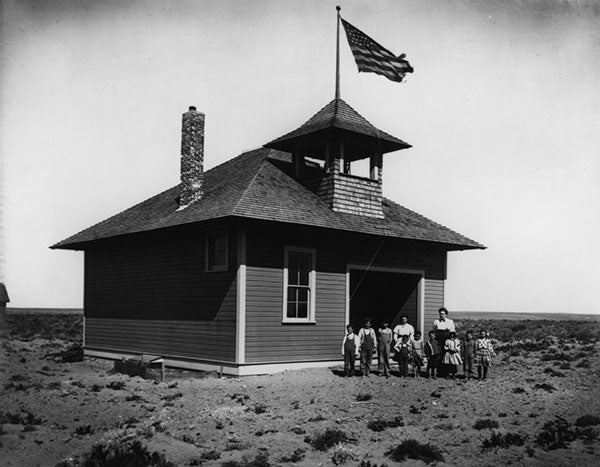


The State Constitution
STATE CONSTITUTIONAL LAW REFLECTS THE FEARS AND HOPES OF A GENERATION
In the strongest language of any state constitution, the framers wrote in Article IX: "It is the
paramount duty of the state to make ample provision for the education of all children...without distinction...on account
of race, color, creed, or sex."
Local Government and Taxes
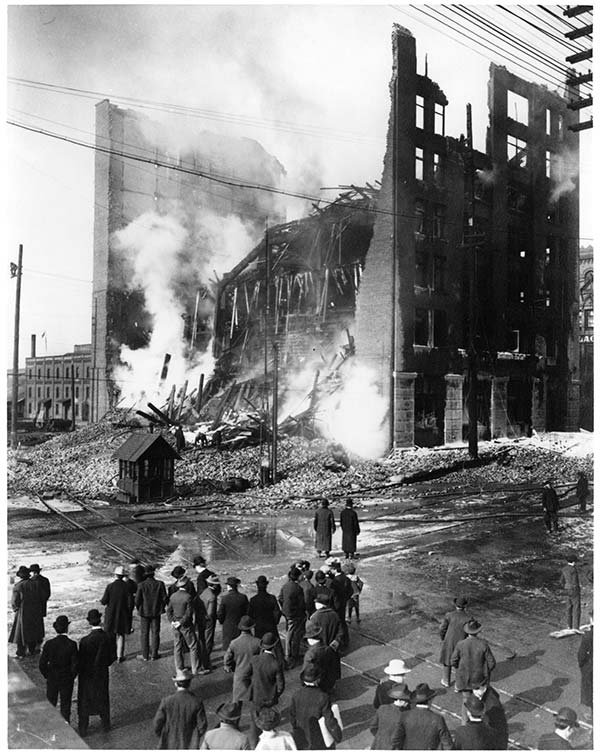
Reports of disastrous fires in Seattle, Spokane and Ellensburg interrupted the State Constitutional Convention in Olympia. The limit of public indebtedness was raised to include local governments to finance the replacement of public buildings and water systems.
Provisions for the organization of cities, towns, and counties as well as for the collection of revenue and taxation are included in the Constitution.
Economic Issues
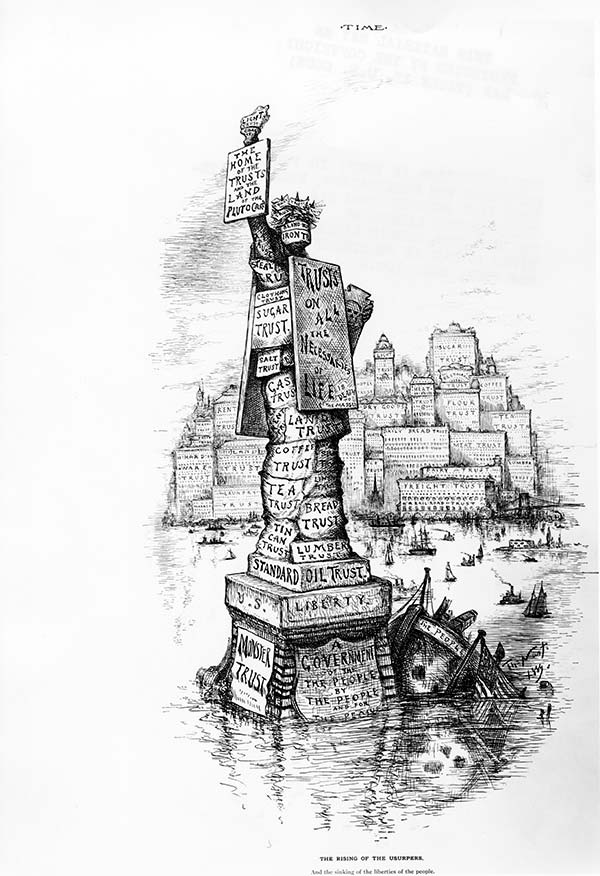
Monopolies and trusts, subject of the first resolution of the State Constitution, were forbidden. The State was not to lend its credit or purchase stock in any company.
Congress passed the Sherman Anti-Trust Act in 1890.
Violence against striking conductors by private detective agents brought a restriction against the corporate employment of armed bodies of men.
The railroad lobby defeated a proposed railroad commission, but future legislators were barred from accepting free rail passes.
Protecting Public Lands
Great potential wealth from timber, minerals and agriculture was at stake, and the preservation of public lands granted with statehood presented the most difficult problem the state constitutional convention faced. Used to finance state governments, such lands in other states were sometimes sold off for as little as ten cents per acre. The state of Washington reserved harbor areas in front of cities, despite railroad opposition, asserted ownership to over 2500 miles of tidelands, and created the office of Commissioner of Public Lands.
Protecting Public Health
The need to regulate the practice of medicine and to control the spread of smallpox and other deadly diseases prompted the creation of a state board of health.
The Legislature was authorized to pass laws for the protection of people working in mines, factories and other employments dangerous to life and health.
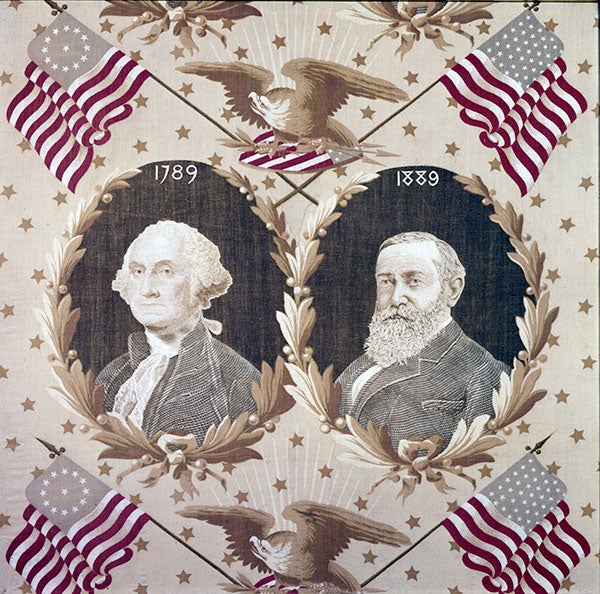


Washington Statehood
STATEHOOD PROCLAIMED BY PRESIDENT BENJAMIN HARRISON NOVEMBER 11, 1889
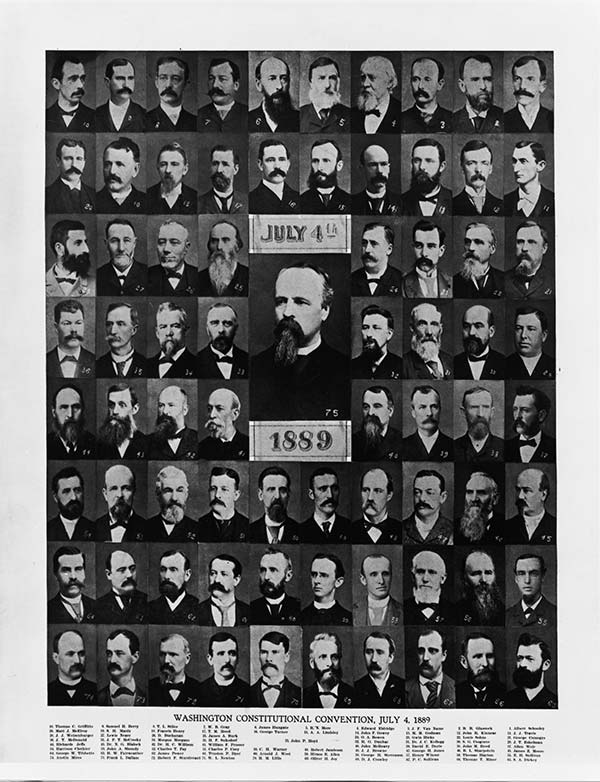
Omnibus bill passed by Congress enabling the admission of Washington, Montana, North and South Dakota as States of the Union - February 22, 1889
Washington Constitution Convention Delegates Elected - May 4, 1889
Constitutional Convention held in Olympia - July 4 to August 16, 1889
State Constitution Ratified by Voters - October 1,1889
Statehood Proclaimed by President Benjamin Harrison - November 11, 1889
Telegram
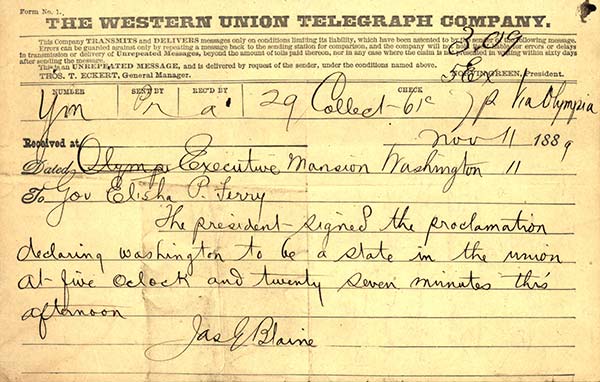
The telegram announcing Washington Statehood arrived collect at 3:09 p.m. on November 11, 1889. Courtesy Washington State Archives.
Proclamation


Handwritten Proclamation of Statehood “Done at the City of Washington” as the nation’s capital was still called at the time. Courtesy The National Archives
First Governor

Arriving at the Territorial Capitol Building, Elisha P. Ferry was inaugurated as the first Governor of Washington State. November 18, 1889. Courtesy Washington State Archives.